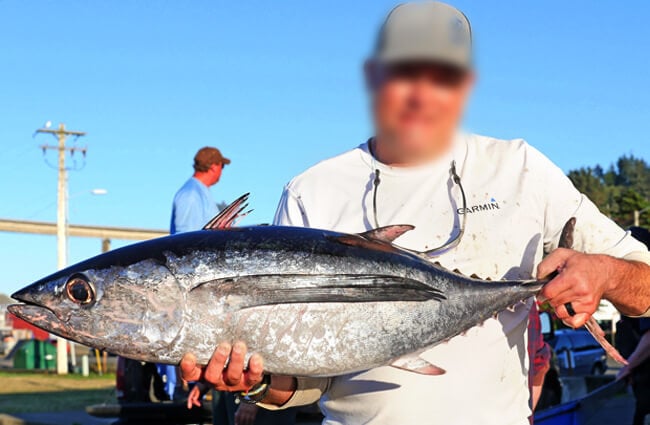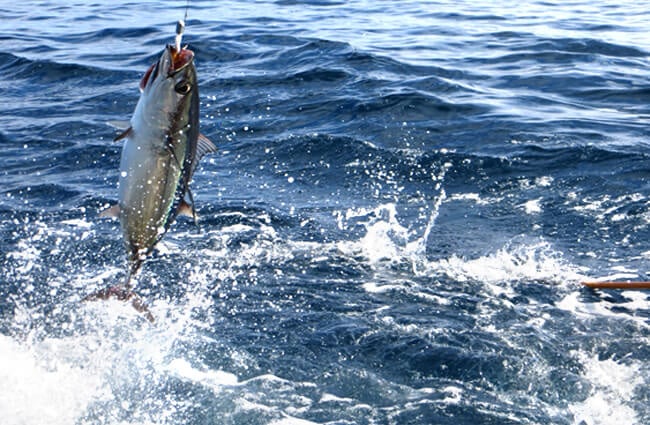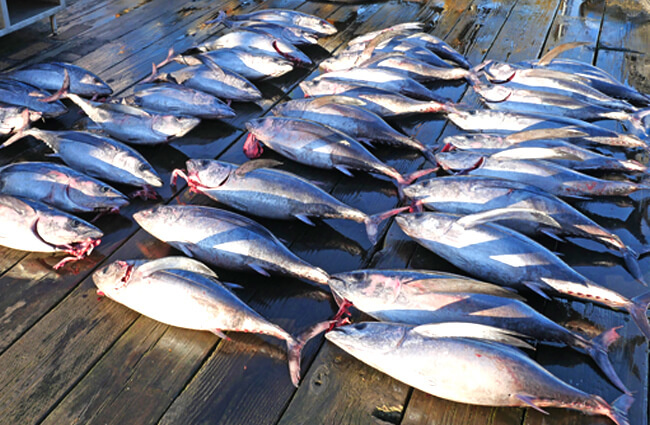The vast, blue expanse of the world’s oceans holds countless wonders, and among the most magnificent are the swift, powerful inhabitants of the open water. One such marvel is the Albacore, a species of tuna renowned for its distinctive long pectoral fins and its incredible migratory journeys. Often recognized by its culinary name, “white meat tuna,” the Albacore is far more than just a food source; it is a vital component of marine ecosystems and a testament to the ocean’s enduring mysteries.
From its sleek, torpedo-shaped body built for speed to its complex life cycle spanning thousands of miles, the Albacore offers a captivating subject for anyone interested in marine biology, conservation, or simply the sheer beauty of nature. This article delves into the fascinating world of the Albacore, exploring its biology, behavior, ecological role, and its intricate relationship with humanity.
An Introduction to the Albacore: The Ocean’s Longfin Traveler
The Albacore, scientifically known as Thunnus alalunga, belongs to the family Scombridae, which includes mackerels and other tunas. It is one of the smaller members of the tuna family, yet it possesses all the characteristic speed and power associated with these apex predators. Its common name, “Albacore,” is believed to derive from the Arabic word “al-bakar,” meaning “the young ones,” or perhaps from “al-bakara,” referring to a type of large sea fish. In many parts of the world, it is simply known as “longfin tuna” due to its most distinguishing feature.
Where Do Albacore Call Home?
Albacore are truly cosmopolitan travelers of the global ocean. Their habitat spans temperate and tropical waters across the Atlantic, Pacific, and Indian Oceans, as well as the Mediterranean Sea. They are pelagic fish, meaning they live in the open ocean, far from the coast and the seabed. These magnificent creatures prefer waters with surface temperatures ranging from approximately 15 to 21 degrees Celsius (59 to 70 degrees Fahrenheit), though they can tolerate a wider range, especially at deeper depths.
Their distribution is not uniform; distinct populations exist in different ocean basins. For instance, the North Pacific Albacore stock is separate from the South Pacific stock, and similar distinctions are made for Atlantic and Indian Ocean populations. These populations undertake vast seasonal migrations, often traveling thousands of miles between their feeding grounds in cooler, richer waters and their spawning grounds in warmer, more tropical regions.
![Big game trolling for AlbacorePhoto by: ALCUSTOM boats [public domain]https://creativecommons.org/licenses/by/2.0/](https://animals.net/wp-content/uploads/2020/02/Albacore-2-1-650x425.jpg)
Physical Characteristics: Built for Speed and Endurance
The Albacore’s physique is a testament to its life in the fast lane of the open ocean. Its body is torpedo-shaped, streamlined, and perfectly adapted for efficient movement through water. Key features include:
- Size: Albacore typically grow to about 1 meter (3.3 feet) in length and can weigh up to 40 kilograms (88 pounds), though larger specimens have been recorded.
- Coloration: The dorsal side is a dark metallic blue, fading to silvery-white on the belly. This countershading provides camouflage in the open ocean, making it harder for predators below to see them against the light surface, and harder for predators above to see them against the dark depths.
- Pectoral Fins: The most distinctive feature is their exceptionally long pectoral fins, which can extend beyond the second dorsal fin. These fins are crucial for stability and maneuvering at high speeds.
- Fins: They possess two dorsal fins, with the second being much smaller than the first. A series of finlets follow both the second dorsal and anal fins, further aiding in hydrodynamic efficiency. The caudal fin, or tail fin, is crescent-shaped and powerful, providing immense thrust.
- Eyes: Relatively large eyes assist in hunting in varying light conditions.
Diet and Feeding Habits: A Voracious Predator
As active predators, Albacore have a diverse and opportunistic diet. Their speed and keen eyesight make them formidable hunters in the pelagic zone. They primarily feed on a variety of smaller fish, cephalopods (like squid and octopus), and crustaceans. Common prey items include:
Albacore are known to feed in schools, often driving baitfish to the surface where they can be more easily caught. Their feeding behavior is crucial for transferring energy up the marine food web, playing a significant role in the health of ocean ecosystems.

Behavior and Social Structure: Schooling for Survival
Albacore are highly social fish, typically found in schools. Schooling behavior offers several advantages:
- Protection: Larger numbers can confuse predators and reduce the chance of any single individual being caught.
- Foraging Efficiency: Coordinated hunting efforts can be more successful in locating and corralling prey.
- Reproduction: Schooling facilitates finding mates during spawning seasons.
These schools often segregate by size, with younger Albacore forming larger, more cohesive groups. They are constantly on the move, following ocean currents and prey availability, undertaking some of the longest migrations of any fish species.
Lifespan and Growth: A Journey Through the Decades
Albacore are relatively long-lived fish for their size, with individuals potentially reaching ages of 9 to 13 years, though average lifespans are often shorter due to fishing pressure and natural predation. Growth rates vary depending on environmental conditions and food availability, but generally, they grow rapidly in their early years, reaching sexual maturity around 3 to 5 years of age.
Deeper Dive: The Science of Albacore
Beyond the basic facts, the Albacore’s life story reveals intricate biological adaptations and ecological significance.
Evolutionary Journey: A Tuna’s Tale
The tuna family (Thunnini) is a highly specialized group of fish within the Scombridae. Their evolutionary history points to a lineage that adapted to a pelagic, predatory lifestyle, developing unique physiological traits like endothermy (the ability to maintain a body temperature warmer than the surrounding water). This “warm-bloodedness” allows tunas, including Albacore, to operate at peak metabolic efficiency, enabling their incredible speed and endurance in cold ocean waters. Fossil records suggest that the ancestors of modern tunas emerged millions of years ago, with their streamlined forms and powerful musculature evolving over time to dominate the open ocean.
Reproduction and Life Cycle: Spawning in Warm Waters
The reproductive strategy of Albacore is tied to their migratory patterns. They are pelagic spawners, releasing eggs and sperm directly into the water column where fertilization occurs externally. Key aspects of their reproduction include:
- Spawning Grounds: Albacore typically migrate to warmer, tropical or subtropical waters to spawn. For example, North Pacific Albacore spawn in the western Pacific, while Atlantic populations spawn in the Sargasso Sea.
- Fecundity: Females are highly fecund, releasing millions of eggs over multiple spawning events during a season. This high reproductive output is a common strategy for pelagic fish, compensating for high mortality rates of eggs and larvae.
- Larval Stage: The eggs hatch into tiny larvae that are planktonic, drifting with ocean currents. These larvae are vulnerable to predation and rely on abundant zooplankton for food.
- Juvenile Development: As they grow, juvenile Albacore begin to develop their characteristic features and schooling behaviors, gradually moving into feeding grounds as they mature.

Ecological Role: A Keystone Species
Albacore play a crucial role in the marine food web. As active predators, they help control populations of smaller fish and cephalopods, preventing overpopulation of these species. In turn, they serve as prey for larger marine predators, including:
- Sharks (e.g., Mako sharks, great white sharks)
- Marine mammals (e.g., Orcas, pilot whales)
- Other large tunas
Their extensive migrations also mean they act as vectors, transferring energy and nutrients across vast ocean basins, connecting different ecosystems. The health of Albacore populations is therefore indicative of the health of the broader pelagic environment.
Migration Patterns: Epic Journeys Across Oceans
The migratory feats of Albacore are legendary. They undertake some of the longest migrations of any fish, often traveling thousands of miles between feeding and spawning grounds. These migrations are influenced by:
- Water Temperature: They follow preferred temperature ranges.
- Food Availability: They move to areas rich in prey.
- Reproductive Needs: They seek warm waters for spawning.
For example, North Pacific Albacore can migrate from the waters off Japan to the coast of North America and back again within a year. These incredible journeys highlight their endurance and the vastness of their oceanic home.
Albacore and Humanity
The relationship between Albacore and humans is multifaceted, ranging from economic importance to cultural significance and, increasingly, conservation concerns.
Cultural Significance and Historical Interaction
For centuries, coastal communities and seafaring cultures have interacted with tuna species, including Albacore. While not always as prominent in ancient art or mythology as some coastal fish, their presence in traditional fisheries has made them a staple for many. In some cultures, the arrival of tuna schools signaled prosperity and provided a vital food source. The pursuit of these powerful fish has also shaped fishing techniques and maritime traditions across the globe.
Commercial Importance: The “White Meat” Tuna
Albacore is highly valued in commercial fisheries worldwide, primarily for its distinctive light-colored flesh, often marketed as “white meat tuna.” It is a popular choice for canning, fresh consumption, and sashimi. Major fishing nations target Albacore using various methods, including:
- Pole and Line: Considered a more sustainable method, targeting individual fish.
- Longline: Uses long lines with many baited hooks, which can have bycatch issues.
- Purse Seine: Large nets encircling schools of fish, often associated with FADs (Fish Aggregating Devices).
The economic impact of Albacore fisheries is substantial, supporting livelihoods for countless fishermen and contributing significantly to the global seafood market.

Conservation Status and Challenges
Like many commercially important fish species, Albacore populations face various threats. Overfishing has historically been a concern for some stocks. Other challenges include:
- Bycatch: Non-target species, including marine mammals, sea turtles, and sharks, can be caught incidentally in tuna fisheries.
- Habitat Degradation: Although pelagic, ocean pollution and climate change can indirectly impact their food sources and migratory routes.
- Climate Change: Shifting ocean temperatures and currents can alter their distribution and reproductive success.
International fisheries management organizations (such as ICCAT for the Atlantic, IATTC for the Eastern Pacific, and WCPFC for the Western and Central Pacific) work to assess stock health, set quotas, and implement regulations to ensure sustainable fishing practices. Consumers can contribute to conservation by choosing sustainably caught Albacore, often identified by certifications like MSC (Marine Stewardship Council).
Human Interaction: Responsible Engagement
For those who wish to observe Albacore in their natural habitat, responsible practices are paramount. This typically involves chartering reputable fishing or wildlife viewing boats that adhere to ethical guidelines. Direct interaction with wild Albacore is rare and generally discouraged for both human safety and the well-being of the fish.
What to do if you encounter an Albacore out of water: While highly unlikely for a “hiker” to encounter a live Albacore far from the ocean, if one were to find a beached or stranded Albacore, the best course of action is to:
- Do not approach or touch it directly: Large fish can be powerful and unpredictable, even when distressed.
- Contact local authorities: Report the sighting to marine wildlife rescue organizations, local fisheries departments, or environmental agencies. They are equipped to assess the situation and provide appropriate assistance, which might involve rescue, rehabilitation, or scientific study.
- Maintain a safe distance: Observe from afar and provide details to the authorities, such as location, size, and any visible injuries.
Interesting Facts and Practical Insights
The world of the Albacore is full of intriguing details and practical considerations for various enthusiasts.
A Huge List of Interesting Facts About Albacore
- Warm-Blooded Wonder: Albacore, like other tunas, are endothermic, meaning they can maintain a body temperature higher than the surrounding water. This allows them to hunt efficiently in colder, deeper waters.
- Speed Demons: Their streamlined bodies and powerful tails enable them to reach impressive speeds, though exact top speeds are difficult to measure in the wild.
- Longest Fins: Their exceptionally long pectoral fins are a defining characteristic, giving them the nickname “longfin tuna.”
- Deep Divers: While often found near the surface, Albacore can dive to considerable depths, sometimes over 600 meters (2,000 feet), in pursuit of prey.
- Global Travelers: They undertake some of the longest migrations of any fish species, crossing entire ocean basins.
- “White Meat” Distinction: Albacore is the only tuna species allowed to be labeled “white meat tuna” in the United States, due to its lighter flesh color and milder flavor compared to other tunas.
- Mercury Levels: Due to their position in the food chain and lifespan, Albacore can accumulate mercury, though generally less than larger tuna species like Bluefin.
- Age Rings: Scientists can determine the age of an Albacore by examining growth rings on its otoliths (ear bones), similar to tree rings.
- Schooling Behavior: They typically school by size, with juveniles forming larger, denser schools.
- Opportunistic Eaters: Their diet is broad, adapting to whatever prey is abundant in their migratory path.
![Albacore, c 1931 Photo by: Queensland State Archives [public domain] https://creativecommons.org/licenses/by/2.0/](https://animals.net/wp-content/uploads/2020/02/Albacore-1-650x425.jpg)
For the Animal Lover: Finding Albacore in the Wild
Observing Albacore in their natural habitat is a thrilling experience, primarily for those interested in offshore fishing or pelagic wildlife viewing. To find Albacore in the wild:
- Location: Focus on temperate and tropical offshore waters of the Atlantic, Pacific, and Indian Oceans. Specific hotspots include the Pacific Northwest coast of North America, the waters off Japan, and parts of the Mediterranean.
- Seasonality: Albacore are migratory, so their presence is seasonal. Research local fishing reports and scientific tagging data to determine peak seasons for your chosen region. For example, off the Oregon coast, late summer and early fall are prime times.
- Methods:
- Charter a Fishing Boat: Many sportfishing charters specialize in tuna trips. This is the most common way to encounter them.
- Wildlife Cruises: Some pelagic birdwatching or whale watching tours might encounter tuna schools, especially if they are feeding at the surface.
- Look for Signs: Keep an eye out for diving seabirds (like shearwaters and terns) or marine mammals (like dolphins) that often feed on the same baitfish as tuna. These are excellent indicators of tuna presence.
- Respect the Ocean: Always choose reputable operators who prioritize sustainable practices and minimize disturbance to marine life.
For the Aspiring Zoologist: Delving Deeper into Albacore Research
The Albacore offers a rich field of study for aspiring zoologists. Key areas of research and learning include:
- Population Dynamics: Understanding stock assessments, recruitment, and mortality rates is crucial for sustainable management.
- Migration Ecology: Studying their incredible journeys using tagging technologies (satellite tags, acoustic tags) reveals insights into ocean currents, climate impacts, and behavioral patterns.
- Physiology: Research into their endothermy, osmoregulation, and high metabolic rates provides fascinating insights into adaptation to the pelagic environment.
- Trophic Ecology: Analyzing their diet and position in the food web helps understand ecosystem health and energy flow.
- Fisheries Science: Investigating the impact of different fishing gears, bycatch reduction strategies, and the socio-economic aspects of tuna fisheries.
Consider internships with marine research institutions, fisheries management agencies, or conservation organizations to gain hands-on experience with these magnificent fish.
For the Zookeeper: The Challenges of Albacore in Captivity
Caring for Albacore in captivity presents immense challenges, so much so that they are rarely, if ever, kept in public aquariums. Their pelagic nature and specific needs make them unsuitable for typical captive environments. However, if one were to consider such an undertaking, the following considerations would be paramount:
- Immense Space Requirements: Albacore are fast, migratory fish that require vast, open spaces to swim continuously without encountering walls. A tank would need to be enormous, likely hundreds of thousands or even millions of gallons, with a circular or oval design to prevent collisions.
- Water Quality and Temperature: Maintaining precise pelagic water conditions, including temperature, salinity, oxygen levels, and nutrient balance, would be extremely complex and energy-intensive.
- Dietary Needs: Providing a consistent supply of varied, high-quality prey items in sufficient quantities to meet their high metabolic demands would be a significant logistical challenge.
- Stress and Acclimation: Capture and transport are highly stressful for pelagic fish, often leading to high mortality rates. Acclimating them to a confined environment would be incredibly difficult.
- Social Structure: Replicating their schooling behavior and providing adequate social interaction in a limited space is nearly impossible.
- Avoidances:
- Small, Rectangular Tanks: These would be fatal due to constant collisions.
- Sudden Changes: Avoid abrupt changes in water parameters, lighting, or feeding schedules.
- Overcrowding: This would lead to stress, aggression, and disease.
- Inadequate Diet: Malnutrition would quickly lead to health issues.
In essence, the specialized needs of Albacore mean that their conservation and study are best conducted in their natural, expansive ocean habitat rather than in captivity.
Conclusion: A Call to Appreciate the Ocean’s White Meat Wonder
The Albacore, with its sleek design, incredible speed, and epic migrations, stands as a symbol of the ocean’s boundless energy and intricate life. From its role as a vital predator in the open ocean to its significant contribution to human economies and cultures, this longfin tuna is a creature of immense importance. Understanding its biology, appreciating its ecological role, and supporting sustainable practices are crucial steps in ensuring that the Albacore continues its magnificent journeys across the world’s oceans for generations to come. The next time you encounter this remarkable fish, whether on a plate or in a documentary, remember the incredible story of survival and adaptation it represents.

![Red Angus Closeup of a beautiful Red Angus cowPhoto by: U.S. Department of Agriculture [pubic domain]https://creativecommons.org/licenses/by/2.0/](https://animals.net/wp-content/uploads/2020/03/Red-Angus-4-238x178.jpg)




![Red Angus Closeup of a beautiful Red Angus cowPhoto by: U.S. Department of Agriculture [pubic domain]https://creativecommons.org/licenses/by/2.0/](https://animals.net/wp-content/uploads/2020/03/Red-Angus-4-100x75.jpg)

